
Back in the 90’s when the Braves had Glavine, Maddux, and Smoltz, Leo Mazzone was hailed as a genius. When he went to the Baltimore Orioles, not so much. Rick Peterson was a genius with Hudson, Mulder, and Zito. With the Mets, he was a scapegoat. He was replaced with Dan Warthen.
Now that the Mets have Matt Harvey, Jacob deGrom, and Noah Syndergaard, Warthen has gained some notoriety. We now hear about the “Warthen Slider.” As is the case, when you get a trio of young aces, all the fame is going to come your way. They point to certain things you do that makes great pitchers great. Typically, pitching coaches get a lot of praise when they have great pitchers. Warthen, who had survived two GMs and two managers, is no different. How good is he really? Perhaps, we are about to find out.
This past offseason the Mets traded Jon Niese. He was once regarded well enough to receive a five year contract extension with two additional team options. Overall, Niese was somewhat disappointing. He’s had shoulder problems. He was 61-61 with a 3.91 ERA and a 1.361 WHIP. I believe it’s fair to say the Mets expected more and didn’t receive it. Now, Niese is a Pittsburgh Pirate where he is now joined with well regarded pitching coach Ray Searage.
Searage is fast developing a reputation as a pitching guru. Unlike most pitching coaches, it’s not because of who he has, but what he does with what he has. Here’s an example of some of his success stories:
- 2012 Twins/White Sox 6-12, 5.34 ERA, 1.468 WHIP
- 2013-2015 Pirates 35-25, 3.26 ERA, 1.241 ERA
- 2011 Yankees 11-11, 5.15 ERA, 1.434 WHIP
- 2012-2013 Pirates 26-21, 3.41 ERA, 1.228 WHIP
- 2014 Phillies 8-18, 4.59 ERA, 1.409 WHIP
- 2015 Pirates 9-7, 3.18 ERA, 1.360 ERA
- 2015 Mariners 4-6, 4.64 ERA, 1.408 WHIP
- 2015 Pirates 7-2, 1.85 ERA, 1.026 WHIP
As noted above, Searage’s next project is Niese. He’s coming off of what might be perhaps the worst year of his career where he went 9-10 with a 4.13 ERA and a 1.398 WHIP. Searage has his work cut out for him, especially with a head strong pitcher like Niese. For his part, Niese is seeing an opportunity for improvement with a superior Pirates defense. Is the Pirates defense Searage’s equivalent to Warthen’s slider? Who knows?
At the end of the day, it’s a results based business, and Searage has done something with his pitchers to coax better results than they have elsewhere. If that continues, Niese is about to have the best year of what has so far been a very disappointing career. It’ll be another pitcher that Searage has been able to reach that other pitching coaches couldn’t.
If that’s true, it doesn’t make Warthen a bad pitching coach. Rather, it shows that like this who have come before him, his perceived skill is more closely tied to the skills possessed by his pitching staff.
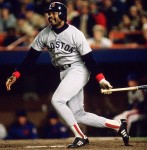
How you view a particular year or period of time completely depends on your perspective. When you bring up 1986 in the New York Metropolitan area, the first thing that comes to mind is the ’86 Mets. As a diehard Mets fan, 1986 should’ve been the greatest year ever.
I became a Mets fan because my Dad saw to it. He did what all Dad’s do to make our sons love the sports teams we love. Basically, he used everything at his disposal. What gave him the most leverage was my love of strawberry ice cream. He used that information to tell me the Mets had this player named Darryl Strawberry who was going to play for the Mets. When Strawberry first got called up in 1983, he brought me to see him play. I was immediately hooked. Right now, I’m using the same tactics with my son to much success even if I have to find him a new favorite player.
Now, I was young when 1986 happened. When I think back to it, I really have one memory from that entire season:
The reason why I remember that moment was my family was hosting an engagement party for my aunt, who lived with us. Instead of this being the families getting to know each other type of party, it turned into everyone watching Game Six of the World Series. I still remember the way everyone celebrated when that “little roller up the first base line” went through Buckner’s legs. I just remember the sheer joy and elation. That moment as much as anything else may be the reason I’m such a huge Mets fan.
It was a moment I remembered when I was watching the 1999 NLCS with my Dad. We just watched John Olerud hit a game-winning single off the hated John Rocker for what we hoped would be the Mets climb to be the first ever team to to come back from an 0-3 deficit. I thought to take the opportunity to talk to my Dad about that 1986 season. I could’ve said a million different things. I could’ve asked about his memories of the season. I could’ve asked how the Mets coming back from an 0-3 deficit would compare to that Game Six rally. I didn’t. Instead, I said to my Dad, “Watching this just reminds you that 1986 was a great year!”
Without skipping a beat, my Dad replied, “Yeah, except for your grandfather dying.”
I was five at the time. While I only had one memory from the entire 1986 season, I can tell you everything about walking into Nana and Grandpa’s house the day my beloved Grandfather died of throat cancer on a beautiful April day. It was a day in which everyone else was thinking about baseball and a soon to start Mets championship season. It was the beginning of a great year for Mets fans. However, for my family, 1986 was decidedly not a good year. We lost a loved one to cancer.
Now, 30 years later the Mets are primed and ready to win another World Series. Over the course of the 2016 season, there will be deaths to mourn, weddings to celebrate, and births that will forever change our lives for the better.
Throughout all of it, baseball is there. Baseball is there to help us to get through the tough times. It’s there to share with our children when they are born, and they become Mets fans of their own. It’s part of what makes baseball great. It’s always there for you. So yes, 1986 was a terrible year for my family. However, the ’86 Mets were a reminder that even it times of sorrow, there is still room for joy, for celebration.
Lets Go Mets!
This article will be run as part of the Baseball Continuum Blogathon. The Blogathon is raising money for the Roswell Park Alliance Foundation, which is the charitable arm of the Roswell Park Cancer Institute in Buffalo, NY.

At the end of the day, baseball is an entertainment product. If it does not deliver what its fans want, they risk losing them.
Much like presidential election time, there doesn’t seem to be just one poll that provides a definitive answer. So instead, we’re going to look at a number of polls to try to find some sort of consensus. Admittedly, each and every single one of these polls has some issues. These issues stem from sample sizes, inability to control people from voting multiple times (on their phone, tablet, or computer), and lastly, we don’t know how the polling question was necessarily presented.
With that said, looking at a number of polls can be informative. Here’s a look at some polls taken on the issue:
- Public Policy Polling found that 55% of people want to see pitcher’s hit
- NJ.com reported 59.41% of people do not want the DH in the National League
- CBS Boston poll results were 52.14% wanted no DH, 30.35% thought both leagues should have the same rules, and 17.51% wanted to leave the current rules in place
- ESPN Radio Cincinnati poll indicates 57% of people do not want the DH in the National League
- A Reddit poll essentially determine AL fans love the DH and NL fans hate it.
I’m sure there are polls that I missed that may prove fans feel differently. I also don’t think that five different polls is definitive. However, it is informative. As the last Reddit poll shows, people seem to like their brand of baseball.
Depending on whether you buy the Abner Doubleday story or not, the game of baseball has been played since 1839. In those 176 years of baseball, somewhere there was a pitcher hitting for himself. It’s apparent not just from these limited poll results, but also from the strong opinions everywhere on the topic, people like the idea of the National League having the pitcher hit.
For those fans who don’t like it, who will not watch a game without a DH, there is the American League. As we see, people seem to care less about the DH, and more about seeing good baseball. If you put two, good, talented, and interesting teams on the field people will watch regardless of whether or not the pitcher is batting for himself.
This is a big game that lasted a lot of years. It lasted through scandals like the Black Sox and steroids in the 90’s. It survived with pitchers hitting. Generally speaking, people like baseball. Many of those people like it with the pitcher hitting. There’s no need to add the DH to the National League.
The fans just don’t want it.
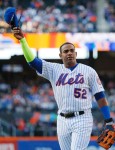
Last year, we got to celebrate Cespedes for only three months. Now that Yoenis Cespedes has re-signed with three Mets, we will have a full year to celebrate Cespedes.
For you new fans, Cespedes is a time that fans gather round Citi Field or their TV sets to watch Yoenis dazzle on the field and lead the Mets to the postseason. If you haven’t been here before, Yoenis hits balls that go really out there. It all starts with the Cespedes bat.
Cespedes Pole
For the Cespedes Pole, you nee something balanced and sturdy. You need something that is strong enough to handle 90+ MPH fastballs but light enough that it can soar in the air with the flick of the wrists.
Throwing Out of Baserunners
Cespedes has a lot of issues with these baserunners trying to take the extra base, and the umpire is going to let them hear about it:
Once the umpire calls there baserunners out, they “couldn’t smooth a silk sheet even if they had a hot date with a babe.” I lost my train of thought.
Feats of Strength
Cespedes isn’t over until Yoenis does a bat flip after a homer.
If we see a repeat of what we saw last year, we can expect a Cespedes Miracle.
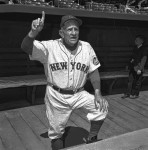
On July 30th, the Mets will be retiring the sixth number in their history (including Jackie Robinson). After the Mets retired Casey Stengel‘s number, the team has been much more stringent in retiring numbers in honor of their former players and managers. In fact, the Mets have only retired the numbers of three of their former players (including the one upcoming this summer). Can you name them? Good luck!

For those that never watched Watch What Happens Live, it’s talk show masquerading as a drinking game. If you’re married, you’ve seen it because it normally follows Real Housewives of [Insert City].
Overall, if you’re looking for anything scandalous, Harvey technically got what a sac fly is wrong. He said it was whenever a batter advances to any base on a flyball out. Technically, it’s only when a runner scores. Other than that, the entire episode was fairly tame, at least with respect to a typical Watch What Happens Live episode.
Initially, Matt Harvey looked awkward sitting there with Cardinals fan Andy Cohen and Nationals fan Connie Chung. First, he wasn’t drinking (looked like water to me). Second, they went right to Connie Chung and her fight with Donald Trump:

Third, Andy didn’t ask Harvey about baseball. He asked more about his grooming and dating habits. He asked “which Met had the biggest bat.” (Note, Andy put it more crudely and bluntly). Harvey didn’t answer that one. If you’re interested, Harvey is single, uses Degree women’s deodorant, flies on private planes, and his teammates gave him a poster of his layout from the ESPN The Body issue. There are other adult topics, which I found amusing, which are neither here or there (Seinfeld roommate switch and on the field in college). Also, unlike the ’86 Mets, Harvey never tried cocaine. Really, Andy didn’t ask any baseball questions, which if you’ve ever watched the show, isn’t all that surprising.
However, Connie Chung asked the question, and he answered the question. Connie Chung grilled him on Terry Collins sending him back in there for the ninth inning. As you can assume, Harvey doesn’t regret the decision. He thought he gave his team the best chance to win. He also said Connie should ask Collins if the manager thought he made a mistake.
As an aside, it’s great that Connie Chung was all over the issue. As you can tell from most of the episode, she doesn’t know much about baseball. However, she knew about this moment. Baseball and the Mets have reached the national consciousness. This is a great thing even if the Mets lost the World Series.
Of course, you should know former teammate, Anthony Recker, was calling in after the show, which is not televised. Andy Cohen made sure to let us know why he was being mentioned at the rear-end of the episode.
It was somewhat bizarre that both my wife and I wanted to watch Watch What Happens Live. It’s also bizarre that Matt Harvey, or any baseball player for that matter, would be on the show. With that said, anytime you’re talking Mets in January, it’s a good thing. It’s even better to see how much this Mets team resonates.
After-Show Update
- Harvey is no longer a Yankee fan
- He wishes Daniel Murphy was able to return to the Mets.
- The Marlins give him more trouble than any other team.
- He’s been training in Boras’ California facility.
- He missed the BBWAA dinner because his driver wasn’t permitted on the roads due to travel restrictions during the blizzard to pick him up.
Oh yeah, Recker never actually called-in. He just left a message.
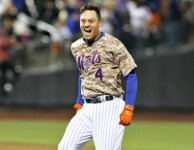
While everyone is trying to decipher the outfield configuration after the Yoenis Cespedes signing, there is the issue of how the signing puts added importance on Wilmer Flores‘ ability to be a backup infielder.
Third Base
Make no mistake. The Mets need Flores to be able to handle the role and handle it well. For starters, we do not know David Wright‘s ability to withstand a full 162 game schedule. Last year, Wright had difficulty playing three days in a row. It impacted his offense and defense. With a full offseason to continue the extra work needed due to his spinal stenosis, that could change for Wright. It also may be a new reality.
Flores has to be ready, willing, and able to play third at a monent’s notice. In his major league career, Flores has only played 209 innings at third base. During that limited time, he did show the ability to handle the position. The problem is he has to work on his third base defense while addressing his second base defense.
Second Base
When the Mets acquired Neil Walker to replace Daniel Murphy, the Mets obtained a switch-hitting second baseman who has hit .272/.338/.427 over the course of his career. That’s with him coming off the worst year of his career last year when he hit .269/.328/.427 with 16 homers and 71 RBI. One of Walker’s issues last year was left-handed pitching. Walker hit a dreadful .237/.284/.290 in 62 games against lefties. For his career, Walker has hit an underwhelming .260/.317/.338 against lefties in his career. Effectively, Walker is a platoon player.
Ideally, that platoon parter would be Flores. However, Flores has to be able to hit lefties himself. Last year, Flores did that with aplomb. In 57 games, Flores hit .310/.355/.600 with 7 of his 16 homers against lefties last year. However, for his career, Flores has only hit .230/.288/.403 against lefties in his brief major league career. Overall, for the Walker trade to work Flores needs to be the 2015 version of himself against lefties as opposed to what he’s done against them in his entire career.
First Base
First base is where it starts to get dicey for Flores. With the Cespedes signing, Lucas Duda became the only player on the roster with any major league experience at first base. This forces Flores to learn a new position in addition to keeping prepared for his other backup roles.
How much Flores is needed will depend on Duda. Last year, Duda hit a respectable .285/.333/.545 with seven homers and 21 RBI in 82 games. However, much of that was fueled by an extraordinarily high BABIP of .385. For his career, Duda has hit .229/.301/.369 with a .321 BABIP. In short, Duda is due for a regression against lefties. It will be Flores’ job to cushion the fall back to earth while hoping his numbers against lefties doesn’t regress either.
Shortstop
The Mets signed Asdrubal Cabrera to be the new everyday shortstop. A role that used to belong to Flores. Cabrera’s backup to open the season should be Ruben Tejada, who actually wrestled the shortstop job away from Flores last year.
Here’s the issue. The one spot Flores isn’t backing up is the one spot he’s most needed. Last year, Cabrera had a -6.0 UZR and a -7 DRS at shortstop. For his career, he has a -55.5 UZR and a -29 DRS at short. Tejada had a -5.6 UZR and a -15 DRS at short last year. For his career, he has a -1.5 UZR and a -20 DRS there. Flores had a -2.5 UZR and a -10 DRS at short last year with a 1.5 UZR and a -13 DRS for his career.
So defensively, Flores is the best shortstop option. However, the Mets are going with Cabrera in the hopes that his .328/.372/.544 second half will carry forward because otherwise the Mets signed a shortstop who has hit .249/.307/.405 in the three years since his last All Star appearance. Ironically, the position Flores is best suited to on this team is not a position he is tops on the depth chart going into next season.
Pinch Hitter
Since this is the National League, Flores will need to be ready to pinch hit for the pitcher or for a left handed when a LOOGY enters the game. In his career, Flores has only had 13 plate appearances where he hit .250/.308/.333. These are around his career numbers of .253/.287/.386. Accordingly, Flores can reasonably be expected to replicate his career batting line as a pinch hitter next year. Whether that’s good or not is a whole other matter.
Conclusion
Surprisingly, much of what the Mets want to do lies on Flores’ shoulders. He had to platoon at second. He had to hit against tough left-handles while playing first. He has to be available at a moment’s notice to play third. He’s available to play each and every one of these roles because the Mets are placing their top shortstop option, Flores, on the bench.
Flores is still only 24 years old. He works hard, and he will do everything he can do to improve and help the team. He’s going to need to be proficient in three to four infield positions because the Mets really need his help.
Editor’s Note: this article first appeared on metsmerized.com

For some reason, when I think of 1986, I only think of the ’86 Mets. I have several ideas why, but it still strikes me as odd that is the correlation I make. No, going into this year, all I thought about was how this is the 30th anniversary of the Mets last World Series title.
Turns out it’s also the 30th anniversary of the Challenger disaster. It was such a bizarre day in seemingly a much different time. Back then, when someone asked a kid what they wanted to be the usual responses were an athlete, a cop, a fireman, an actor, whatever their father did, or an astronaut. Being an astronaut was such a huge deal. Every launch was an event. I’m not sure either of those was the case.
The Challenger liftoff was a huge deal. Teachers combined classes together, and they lugged in those televisions on those large aluminum carts with the squeaky wheel. In my Kindergarten class, we all sat on our carpet squares, and we anticipated the liftoff. The teachers tried to get us to countdown, but I’m not sure how successful they were. The liftoff happened, and we all started cheering. Then the explosion happened.
The TV was quickly turned off. The teachers seemed to know what was happening immediately (even if they didn’t quite know at CNN), and they didn’t want Kindergartners to see the horror that ensued. We were quickly ushered into a new activity. We were all handed notes on our way out the door advising our parents what happened.
When I got home from school, I remembered going outside and playing with my friends. We didn’t really know what happened. We all thought we saw a really cool liftoff. Ironically, we were all pretending to be astronauts that day really knowing the horrors that had ensued. Then my father came home, and I was summoned inside the house. That usually was never a good thing.
My parents then explained to me what happened. When you’re five, it’s a hard concept to fully grasp. Back then, I wasn’t sure what was happening or why the speech. Looking back on it 30 years later, I believe my parents were trying to prepare me for when my grandfather died. At the time, he was dying from throat cancer. I knew he was sick, but back then I thought being sick was not feeling good, drinking some ginger ale, and watching cartoons all day until you felt better.
I remember both having a lot of questions and just wanting to go and play with my friends again. After our talk, my parents turned on the television, and we watched President Reagan address the nation:
The Challenger explosion was the beginning what was an eventful 1986. It was a year, I too lost a family member like families of the Challenger crew. I’m sure it’s of little consolation to them, but their loss helped me process and understand my grandfather’s passing less than three months later.
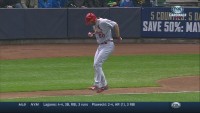
One of the reasons offered for the institution of the DH is to protect pitchers. Pitchers are expensive, and you don’t want them getting injured at the plate or on the basepaths. The theory is the DH would prevent these pitcher injuries.
On the surface, it seems like a reasonable argument. Last year, pitchers made 243 trips to the DL. That’s 213 times more than any other position. Of those 243 trips to the DL, guess how many of them were batter or basepath injuries? There was only one pitcher. Adam Wainwright suffered a torn Achillies tendon while swinging the bat. It’s true that Wainwright was injured while batting, but was he injured because he was batting?
Achillies tendon injuries are due to overuse or tightness in the muscles and tendons. Achillies tendon injuries are common in people who play sports, including baseball players. People who are in their thirties or forties, like Wainwright, are more susceptible to an Achillies injury. Overall, unless you’re involved in a serious accident, an Achillies tendon tear is not caused by any one event.
Yes, Wainwright injured himself while batting, but that was not the cause of his injury. Unfortunately, as is the nature of Achillies tendon injuries, it’s not one event, it’s a multitude of events. The specific act of batting for Wainwright is the straw that broke the camel’s back. It wasn’t the reason he tore his Achillies tendon. It doesn’t work that way.
Yes, there are pitchers who are legitimately injured at the plate or on the basepaths. There are examples, which include getting hit by a pitch, swinging a bat, or running the bases. However, these injuries are few and far between.
Let’s look at it from another perspective. Next to pitchers, left fielders went to the DL more than any other position last year with 30 trips to the DL last year. Let’s assume for a minute each and every single one of the DL trips by left fielders were sustained as a result of batting or baserunning activities. Let’s further assume that regardless of position, any position on the field will have 30 trips to the DL as a result of batting or baserunning activities. Finally, let’s assume these 30 DL trips were already a part of the DL trips made by pitchers last year (this way the denominator of total DL trips isn’t increased).
With all these assumptions, batting and baserunning injuries would only comprise 12.3% of all pitcher injuries. That tells us that the real issue with pitchers is that they get injured with pitching. They rarely get injured batting or running the bases. In fact, the real percentage of pitchers getting injured at the plate or on the basepaths 0% – 0.004% of the time depending on what you believe the cause of Adam Wainwright’s injury was.
If you want to solve the problems with pitchers getting injured, find a way to protect their arms. Keeping them off the basepaths isn’t going to keep them healthy. This is not the reason to add a DH to the National League.
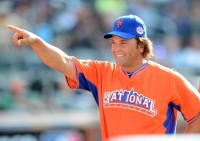
Over at Brew and Orange, they are doing a giveaway for the person who has the best Mike Piazza story. Since the giveaway includes Rheingold beer accessories, which was once the beer of the Mets and my grandfather’s beer of choice, I’m interested. I suggest you go to his site and so your own submission. This is mine.
Back in 2013, my wife was pregnant with our son. At that time, I was already planning on how to make him a Mets fan. We ordered him a knit Mets cap. When I talked to him, I would read books, and of course, I would tell him about the Mets because, well, I have problems. No one believes me, except my wife who was obviously there for this, but I would say, “Lets Go Mets!” and he would kick back three times in the same rhythmic pattern. I digress.
In 2013, the Mets also hosted the All Star Game. For various reasons, my family only went to All Star Sunday, which is the Future’s Game and the All Star Legends and Celebrity All Star Game. My wife suggested we take one of the several Mets onesies we had to get it autographed for the baby. I thought it was a great idea because I would be seeing future Met All Stars like Noah Syndergaard as well as former Met greats like Mike Piazza.
Now, at the time I did work with a guy who used to play minor league ball. In fact, he had a cup of coffee in the majors. He refers to himself as the modern day Moonlight Graham because while he got to play one game, he never got an at bat. The strike happened, and his career was over. This guy told me he played on the same minor league team as Mike Piazza, and he knew him. When I told him my plan, he said he would reach out to him, and he would work to get me that autograph for my son. He eventually told me that I should go meet Piazza by the home dugout after the softball game was over to get my autograph.
With the Future’s Game and Softball Game, I tried to get the onesie signed with no luck. I was alright with that because Piazza was the prize, and I knew exactly when and where to meet him. After the game was over, I made my way down to the home dugout area.
Initially, there was no sight of Piazza. Then again, the area was flooded with people interviewing Kevin James, who was the MVP of the game. No one was really signing anything at the time except him. I just waited there for when Piazza was going to come out and give autographs. I was standing at the exact place and location I was told to stand. I waited and waited and stubbornly waited. Then it happened! Piazza emerged from the home dugout . . . and he immediately made a beeline to the visitor’s dugout area.
I thought this can’t be happening. Something must’ve been lost in translation. Mike Piazza was going to be there looking for me, and I wasn’t going to be there. I was going to miss out on getting an autograph for my son. I then did what every parent does when they are trying to get something for their child. They act quickly and somewhat irrationally. I started jumping the walls that separate each section to get over to Piazza as quickly as possible.
Keep in mind that as I’m doing this there is literally almost no one left at Citi Field. An usher half my size (I’m between 6’5″ – 6’7″ depending on the 7-11) grabs my arm and begins screaming at me. There was some nonsense about respecting Citi Field and how I’m acting like a hoodlum. I exchanged pleasantries as well, but I made sure not to respond physically.
The guy “ushered” me to the stop of the section and turned me over to police explaining the situation. Before I could get a word in edgewise, the police said they saw the whole thing. They mocked the usher and told him to stop bothering me. I explained to the police what I was trying to do, and I sought their help. They told me they couldn’t help and told me I should probably just head home. I was undeterred. I began running all the way to the other side of Citi Field.
By the way, I’m really slow. Almost embarrassingly so. While Piazza might’ve still be there during the hoopla with the usher, he most certainly was not there when I got over there. I went into one of the nearest suites to stand in the air conditioning for a second. Standing there was my brother who actually thought I was fleeing police and security . . . as if that was possible. While I was a free man, I didn’t have Piazza’s autograph.
I went to work the next day, and I apologized to the guy who set everything up. He then began laughing hysterically. He then explained that he did hang out with Piazza a few times in the minors, but he never reached out to him. He had no idea how. I was baffled. I asked him why did he concoct that whe scenario. His response was basically that he figured if Piazza was signing anything, he would do it there. He also figured if Piazza didn’t sign anything he would just say something came up like it does all the time.
Fortunately, I was able to get Mets to sign the onesie and other items for my son. I have a framed Darryl Strawberry jersey (that’s another story) for him. What I don’t have is a Mike Piazza autograph. I’m not sure if I’ll ever get a chance again.
Overall, all of my chances were ushered out the door in July 2013.
